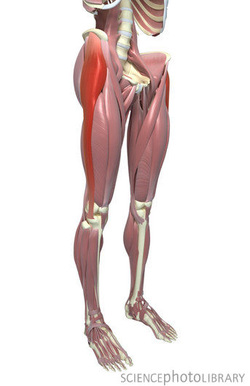Iliotibial Band (ITB)

The Iliotibial Band or ITB is not a muscle but a lateral thickening of the connective tissue (fascia lata) surrounding the thigh. It runs down the side of the thigh from the top of the hip bone to the side of the knee. The ITB functions to stabilize the knee during walking and running.
The ITB can be a source of knee pain, especially in runners. ITB Contracture, a shortening of the band, and ITB Friction Syndrome, inflammation where the ITB crosses the knee joint, are both common problems associated with the iliotibial band. Causes of these conditions vary, but are mostly associated with overuse in activities such as running, cycling, horseback riding, long-distance driving etc., postural dysfunctions and poor stretching habits.
The ITB can be a source of knee pain, especially in runners. ITB Contracture, a shortening of the band, and ITB Friction Syndrome, inflammation where the ITB crosses the knee joint, are both common problems associated with the iliotibial band. Causes of these conditions vary, but are mostly associated with overuse in activities such as running, cycling, horseback riding, long-distance driving etc., postural dysfunctions and poor stretching habits.
1. Standing Stretch
|
This video shows a basic standing stretch for the Iliotibial Band. Iliotibial Band stretches should be held for 90 seconds to achieve optimal results.
|
2. Supported Standing Stretch
|
Here, the same stretch is shown using the wall for support if needed. Be sure to hold this stretch for 90 seconds to achieve results.
|
3. ITB Warm-Up
|
This video shows a good warm-up for the IT Band and Piriformis muscles. This warm-up is useful prior to a walk or run, or can be used intermittently when you find yourself in the seated position for a prolonged period of time (ie: traveling by car, plane etc.). This will help to decrease the development of pain and stiffness upon standing.
|

